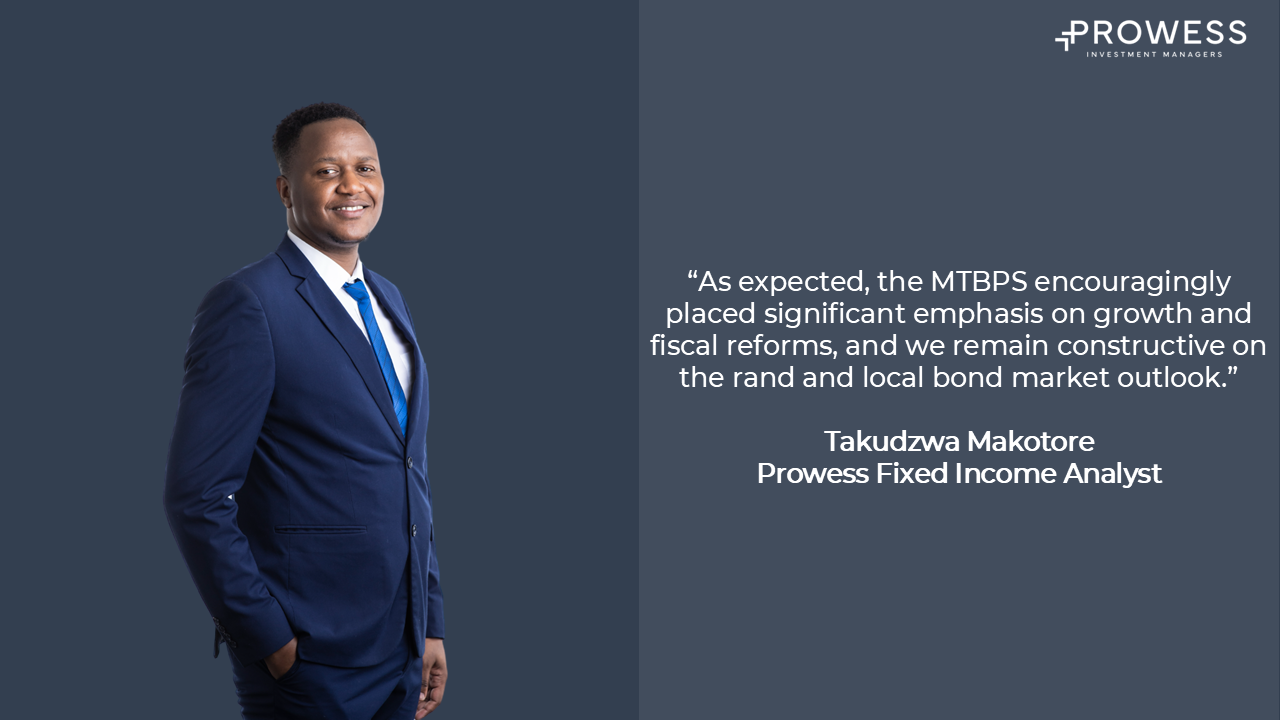Back in October, Finance Minister Enoch Godongwana tabled the 2024 Medium Term Budget Policy Statement (MTBPS), projecting cautious economic growth (2024: 1.1%; 2025-2027: 1.7%) while emphasizing the need for infrastructure investment. The bond market saw minimal surprises, with bond supply unchanged despite an increased cash balance. Fiscal forecasts slightly worsened due to lower tax revenue and modest spending growth. National Treasury maintained its focus towards achieving fiscal consolidation and debt stabilisation by 2025/26, despite challenges such as the state-owned enterprise (SOE) bailouts and steep public wage increases. Continuity from the February 2024 budget underscores Treasury’s intent to restore fiscal credibility amid deteriorating fiscal conditions.
In the policy statement, domestic GDP growth is projected at 1.1% for 2024, down from 1.3% forecast in February, while global growth is estimated at 3.2% for 2024 and 2025. The fiscal outlook deteriorated, with the budget deficit widening to -5.0% of GDP in 2024/25, and debt-to-GDP rising to 74.7%, peaking at 75.5% in 2025/26. Revenue shortfalls (-R15bn in 2024) and increased expenditures (+R26bn) contributed to the worsening metrics, driven by SOE debt repayments, SOE bailouts, public service costs and infrastructure spending.
Efforts to stabilise borrowing include achieving a growing primary surplus and reducing gross debt to 67% of GDP by 2032/33. However, persistent fiscal slippage and gross debt exceeding the 60% sustainable threshold raises concerns about fiscal sustainability. In the statement, investment in economic development was prioritized, with infrastructure spending projected to grow at 10.9% annually. However, increasing regulatory burdens could be a deterrent to foreign direct investment (FDI).
Despite no mention of new support for SOEs in October’s MTBPS, the Minister highlighted several initiatives aimed at fostering a favourable environment for private sector participation in addressing the country’s public infrastructure problems. By 2025/26, the government aims to consolidate project preparation, Public-Private Partnership (PPP) transaction advice and ringfenced financing into a unified structure, combining the efforts of the DBSA’s Infrastructure Fund and the Government Technical Advisory Centre. Financing mechanisms like bilateral loans, concessional financing and infrastructure bonds will be expanded. A credit guarantee vehicle, developed with the World Bank and private reinsurers, is set to mitigate risks for private developers and lenders, starting in the energy sector by late 2025. On SOEs, National Treasury (NT) plans to finalize a R70 billion takeover of Eskom’s debt by 2025/26, potentially converting it into equity if liquidity issues persist. NT also aims to streamline public sector costs, linking wage increases to inflation while maintaining fiscal discipline to safeguard debt sustainability.
Global factors, particularly U.S. economic trends, heavily influence the rand and local market dynamics. Despite concerns with fiscal spillage, the MTBPS did not result in a credit rating downgrade. SA’s fiscal and economic outlook received a boost as S&P changed the country’s credit rating outlook from stable to positive, following the MTBPS. S&P currently rates South Africa’s foreign currency debt at BB- and its local currency debt at BB, with Moody’s rating both slightly higher at Ba2, and Fitch having the lowest assessment at BB- for both. S&P’s positive outlook reflects potential economic growth improvements and debt stabilization, contingent on the new coalition government’s commitment to reforms, fiscal predictability and limiting SOE support. Despite conservative growth forecasts (averaging 1.3% from 2024-2027) and a projected rise in debt to 80% of GDP by FY27, S&P’s shift suggests a possible rating upgrade in 18 months. This positive endorsement is supportive of the rand and local bonds, as it indicates cautious optimism for fiscal sustainability and growth against a tough global backdrop.
We believe the budget is solid overall given the current challenging global and local macroeconomic headwinds. Our view is in line with foreign investor sentiment, as we saw little impact on foreign investment after the MTBPS was tabled. National Treasury remains committed to debt-stabilising primary budget surpluses. There was nonetheless some fiscal slippage (relative to the 2024 Budget forecasts), which was modestly worse than we expected in the medium term. As expected, the MTBPS encouragingly placed significant emphasis on growth and fiscal reforms. We remain constructive on the rand and local bond market outlook as evidenced by the rand’s outperformance against other Emerging Market currencies.


